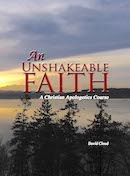__________
A recent research article by Gibson, & Glass et. al.(J. Craig Venter Institute), in Science titled “Creation of a Bacterial Cell Controlled by a Chemically Synthesized Genome” was heralded by the media with the sensational claim that “Scientist Creates Life” (see Time.com).
What exactly did this group of researchers do that would warrant such a fantastic claim? What can we learn from their research? What conclusions can we draw from their accomplishments? To answer these questions, I went beyond the media reports and reviewed the original scientific article published by this group of researchers.
Simply put, these researchers transplanted the DNA of one bacteria into another bacteria, and the recipient bacteria took on the characteristics of the donor bacteria and replicated itself.
First, Venter and colleagues looked for a simple bacteria whose genome had been already mapped and recorded digitally on computer. They used the genome of a bacteria named Mycoplasma mycoides which has about one million base pairs in its DNA sequence (in comparison, the human genome has 3 billion base pairs in its DNA). Other researchers had already discovered the sequence of arrangement of the one million base pairs (DNA building blocks) in the DNA of this bacteria. Knowing the arrangement of the base pairs, they used a variety of techniques to assemble the one million base pairs to form a “synthetic” DNA strand of this bacteria.
Next, the researchers looked for a living bacterial cell belonging to another, but similar bacterial species, to use as a recipient of the DNA that they had assembled. They used a similar bacteria named Mycoplasma Capricolum. After many failed trials, they were able to obtain a successful transplant, to the extent that the recipient cell was able to live and undergo continuous cell replication.
Many have characterized this as the creation of life. In their research article, the researchers liken the DNA to computer software, and the cell and its cytoplasm (everything other than the DNA) to computer hardware. On their website, they state “This synthetic genome has been “booted up” in a cell to create the first cell controlled completely by a synthetic genome.” In other words, they took the operating system software of one type of bacteria, and put it into a second type of bacteria, and the second type of bacteria functioned as if it were the first type of bacteria.
In an analogous account, two years ago, I bought a new Macintosh Computer that had a similar central processing unit (hardware) to a PC computer. I took the Windows Operating System software for the PC computer and loaded it onto the Mac Computer, and booted it up. And the Mac computer worked like a PC computer! It would be ridiculous to now claim that I had created a new computer. It would make no difference if I had first dissected and analyzed the Windows Software, made a copy of the parts of the program, and then reassembled it before loading it onto the Mac Computer.
Similarly, these researchers have not created life. What they did was copy existing information for life, assemble it into a DNA strand, and put it into a living cell, and the cell continued to live. It was not even a dead cell. Furthermore, in assembling the strand of DNA, they needed to utilize proteins and enzymes that were coded for by the DNA itself (a “which came first: the chicken or the egg?” scenario). They even had to use a yeast cell to assemble some of the parts of the DNA strand. Also, the new cell line needed to use the proteins of the old cell line to live and replicate until it could build its own proteins from the donor DNA strand. They did not create even one protein, much less life.
Nevertheless, their accomplishments are not insignificant. This latest achievement was built on 15 years of previous research of their own, plus the research of thousands of other scientists over many decades. During their present research, they refined many techniques to overcome hurdles that resulted in many failed attempts at a successful transplantation of the DNA. In their article, they stated that “our success was thwarted for many weeks by a single base pair deletion in the essential gene dnaA. One wrong base out of over one million in an essential gene rendered the genome inactive...”
Their research should serve to give us a greater appreciation of the complexity and precision of the genetic code. Also, they were able to place a few base pairs in a “non-essential” part of the genome to serve as a personalized label for this “synthetic” genome. Using the 64 possible triplet combinations of the four types of bases in the DNA, they formulated a way to symbolize the alphabet and punctuation using the DNA. One of their labels placed in the DNA was a quote “First to live, to err, to fall, to triumph and to create life out of life.” Of this quote, Venter says “The chances of finding these sequences in the natural genome are close to zero.” By this statement, Venter recognizes the impossibility of information arising by random chance, and in doing so, he unwittingly acknowledges the existence of an intelligent designer.
It behooves these researchers, and everyone, for that matter, to give credit to the Creator of all things, the God of the Bible. The Bible states “I will praise thee; for I am fearfully and wonderfully made: marvellous are thy works; and that my soul knoweth right well.” (Psalms 139:14). Johann Kepler, the father of modern Astronomy, stated, “O God, I am thinking thy thoughts after Thee.” Michael Faraday, the father of Electromagnetism stated, “I cannot doubt that a glorious discovery in natural knowledge, and the wisdom and power of God in the creation, is awaiting our age, and that we may not only hope to see it, but even be honoured to help in obtaining the victory over present ignorance and future knowledge.”
It is lamentable that many contemporary scientists fail to give the credit where it is due. Many scientists accept the praises of men as if they were the creator of the things that they have only discovered. Instead of claiming to have created life, or accepting the claims of others on their behalf, these researchers should give the glory to God who “in six days... made heaven and earth, the sea, and all that in them is” (Exodus 20:11).
Johann Kepler also stated, “... since we astronomers are priests of the highest God in regard to the book of nature, it befits us to be thoughtful not of the glory of our minds, but rather, above all else, of the glory of God.”
Those that would accept praise that belongs only to God, or somehow equate themselves with God, place themselves in an unenviable position. We read of such a man in the Bible, Herod the king.
“And upon a set day Herod, arrayed in royal apparel, sat upon his throne, and made an oration unto them. And the people gave a shout, saying, It is the voice of a god, and not of a man. And immediately the angel of the Lord smote him, because he gave not God the glory: and he was eaten of worms, and gave up the ghost” (Acts 12: 21-23).
These researchers would do well to heed the Scriptures and praise God for the things they have discovered. “Great is our Lord, and of great power: his understanding is infinite” (Psalm 1:5).
- Receive these reports by email
- www.wayoflife.org
______________________
Sharing Policy: Much of our material is available for free, such as the hundreds of articles at the Way of Life web site. Other items we sell to help fund our expensive literature and foreign church planting ministries. Way of Life's content falls into two categories: sharable and non-sharable. Things that we encourage you to share include the audio sermons, O Timothy magazine, FBIS articles, and the free eVideos and free eBooks. You are welcome to make copies of these at your own expense and share them with friends and family. You may also post parts of reports and/or entire reports to websites, blogs, etc as long as you give proper credit (citation). A link to the original report is very much appreciated as the reports are frequently updated and/or expanded. Things we do not want copied and distributed are "Store" items like the Fundamental Baptist Digital Library, print editions of our books, electronic editions of the books that we sell, the videos that we sell, etc. The items have taken years to produce at enormous expense in time and money, and we use the income from sales to help fund the ministry. We trust that your Christian honesty will preserve the integrity of this policy. "For the scripture saith, Thou shalt not muzzle the ox that treadeth out the corn. And, The labourer is worthy of his reward" (1 Timothy 5:18). Questions? support@wayoflife.org
Goal:Distributed by Way of Life Literature Inc., the Fundamental Baptist Information Service is an e-mail posting for Bible-believing Christians. Established in 1974, Way of Life Literature is a fundamental Baptist preaching and publishing ministry based in Bethel Baptist Church, London, Ontario, of which Wilbert Unger is the founding Pastor. Brother Cloud lives in South Asia where he has been a church planting missionary since 1979. Our primary goal with the FBIS is to provide material to assist preachers in the edification and protection of the churches.
Offering: Offerings are welcome if you care to make one. If you have been helped and/or blessed by our material offerings can be mailed or made online with with Visa, Mastercard, Discover, or Paypal. For information see: www.wayoflife.org/about/makeanoffering.html.





